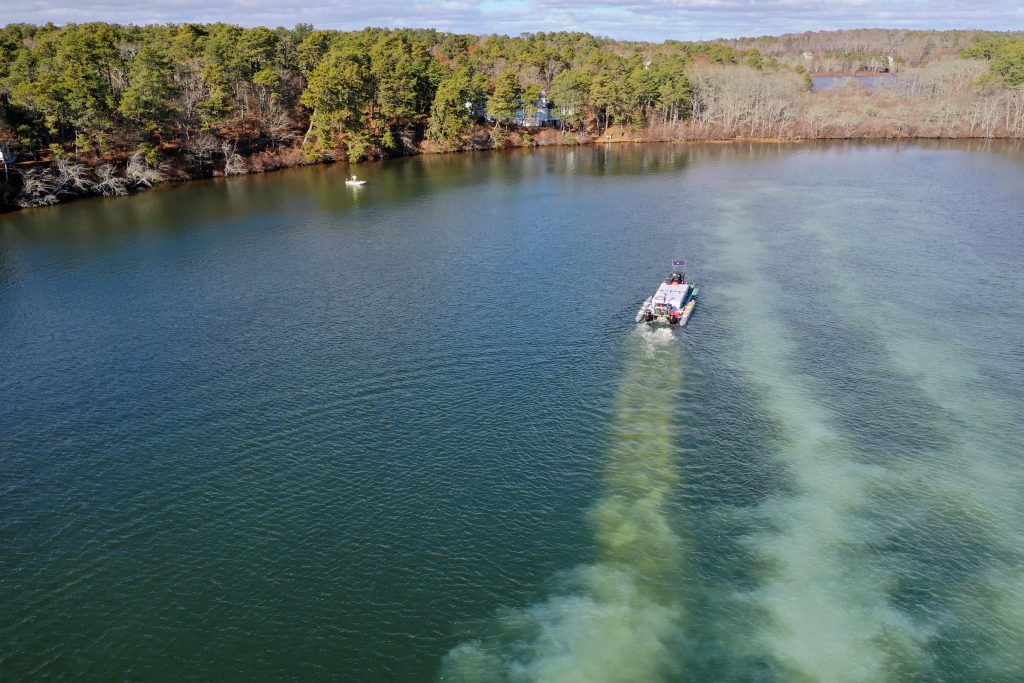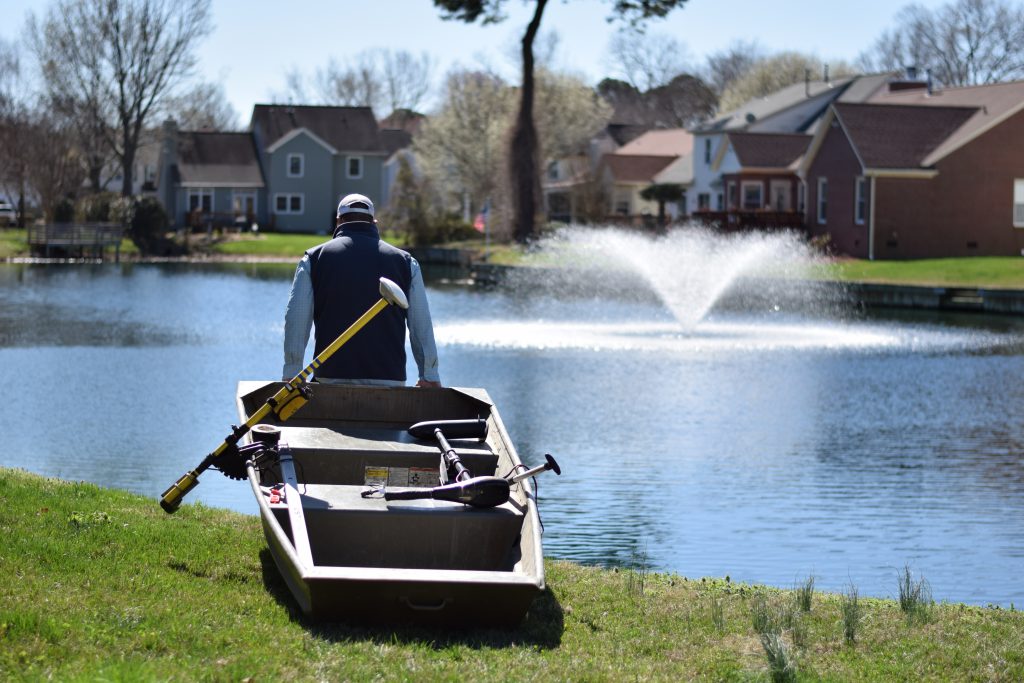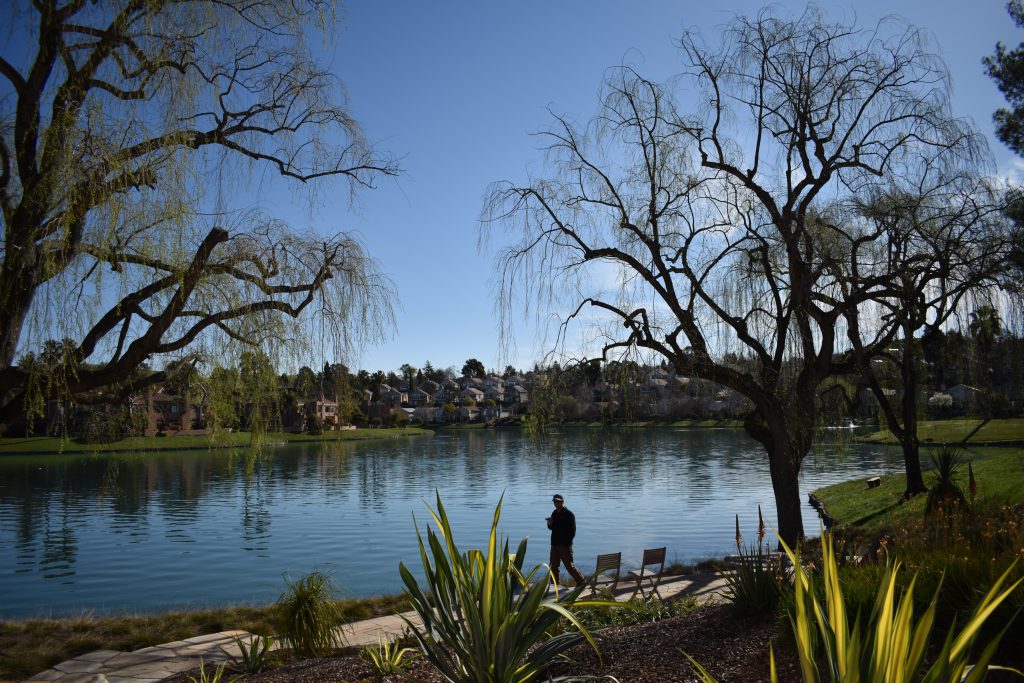
Did You Know? Professional Answers to 8 Common Lake & Pond Questions
Despite the beauty, recreational space and natural wildlife habitats that our nearby waterbodies provide, lakes and ponds are often plagued by various ailments that can detract from the aesthetics, health, and functionality of their aquatic ecosystems. The following are a few responses to common questions often asked by those interested in lake and pond management.

Why is our pond green?
Without proper water quality testing and analysis, it can be difficult to determine the exact causes behind a green pond. The green you’re seeing may be algae. While algae look similar to some aquatic plants, they lack true roots, stems, and leaves, and can be present in one of two forms, or both: microscopic or filamentous. Microscopic algae are single-cell plants suspended within the water column, usually resulting in a “pea-soup” look. Microscopic algae, specifically cyanobacteria (blue-green algae), are capable of producing toxins, which can be detrimental to human and wildlife health. Filamentous algae has a “stringy” look and often creates large mats on the water’s surface or along the bottom. Additionally, some common floating green plants can also cover a waterbody’s surface, like watermeal (Wolffia sp.), duckweed (Lemna sp.), and water chestnut (Trapa natans). Excessive pond algae growth is usually the result of increased nutrient input, such as fertilizer or agricultural runoff; however, other causes are possible. A professional lake or pond manager can help accurately identify the source of the problem and develop an effective management plan.

Is the pond safe for swimming? How can we tell?
The best approach for validating safe water is periodic water quality analysis. Professional water quality consultants can identify problematic conditions within the aquatic ecosystem, and help determine the best management strategy to make it recreationally safe. There are some visual ways to determine if a pond is safe for swimming. Using basic observatory skills and judgment, some “red flags” of unsafe waters can indicate the need for water quality testing. Water color is a good primary indicator of water quality; if it is noticeably different or unusual (i.e. green, soupy-looking), there is likely an issue. Although green water may indicate an algae bloom, not all algae are green and some can produce harmful toxins. Another red flag is scent; foul odors can be produced by harmful factors within the waterbody, and can indicate that something is wrong. A visible fish kill or other wildlife impacts also signal that the waterbody is unfit for use.
Aquatic plants may not seem problematic, but can be dangerous if they are dense and high within the water column as they could become tangled in the legs of swimmers or boat propellers. Although signs of unsafe water are not always inherently obvious, good judgment and observation can offer a lot of information. If you or someone you know are uncertain about vegetation growth or water quality safety, contact a lake or pond management professional for direction.

How do we get rid of algae?
Algae blooms can be the result of various factors, but are usually due to excessive nutrient loading from fertilizers, sewage and animal waste. Identifying and quantifying nutrient sources, both internally and externally, is the first step in developing a successful algae management plan. The original nutrient source should be addressed, if feasible, to minimize the potential for future algae issues. Appropriate proactive management should follow to ensure long-term results.
Nutrient mitigation treatment can be performed by a licensed professional to remove available nutrients from within the waterbody. In some cases, installation and use of an aerator can aid in algae growth mitigation. Aeration systems increase available dissolved oxygen within the water; this supports the breakdown of organic matter and consumption of excess nutrients present, potentially discouraging algae growth. Pond aeration systems are available as submersed diffusers or as floating fountain features. Algaecide treatments conducted by licensed applicators can occasionally be necessary, in combination with other efforts, to overcome an algae issue as well.

How do we treat invasive aquatic plants like milfoil?
Milfoil is a non-native, invasive species that plagues many lakes and ponds throughout most of the United States. Milfoil plants have feather-like leaves, and are capable of thriving in wide ranges of aquatic habitats. Other invasive species commonly found are: curlyleaf pondweed (Potamogeton crispus), fanwort (Cabomba caroliniana), hydrilla (Hydrilla verticillata), brittle naiad (Najas minor), water chestnut (Trapa natans), purple loosestrife (Lythrum salicaria), and common reed (Phragmites australis). For all of these species, milfoils included, there are various management options available, but most common is aquatic herbicide treatment.
Treatment is usually performed via boat and subsurface injection to target growth areas. Physical removal using a mechanical harvester or hydro-rake can be used for some species (e.g. water chestnut and common reed); this is not recommended for species like milfoils as they spread through plant fragmentation. Smaller scale options, such as bottom barriers, are also available but have site- and plant-specific applicability.

Why is our waterbody murky?
If the water is murky and a brown or tan-ish color, sediment particles are likely suspended within the water column. This often happens after a large rain event, so shoreline areas should be inspected to identify places of erosion where sediment has been entering the water. Ideally, this sediment input should be addressed and minimized, as stormwater runoff often carries nutrients too. In some cases, murky water can also be due to an algal bloom as algae is not always green. Some algae species are actually red, brown, or golden, and can bloom at various times of the year. A murky pond could also be a sign that water levels in the waterbody are too low. Bathymetry studies every 3-5 years are the best way to determine if a pond is filling in with sediment, and can indicate when it is necessary to conduct hydro-raking or dredging efforts.

Our pond is filling in – what can we do?
Sediment and organic matter often accumulate within waterbodies over many years. Hydro-raking is available as an option to regain depth by removing plant material and unconsolidated bottom sediment. A hydro-rake is essentially a floating backhoe with a York-rake attachment and can remove nuisance vegetation and bottom debris from depths up to 10 feet. The removed material is placed onshore to de-water before its eventual removal to a composting site. Removal of plant material and unconsolidated bottom sediments reduces pond nutrients and maintains open water habitat. Hydro-raking offers an affordable alternative to dredging, which can be a tremendous expense for a community, while potentially being more site-specific depending on the project.

Our pond has a lot of cattails – how can we manage that?
Cattails can either be beneficial or a nuisance, depending on the size of the waterbody where they are located. If in scattered patches along the shoreline of a larger lake, cattails can provide great habitat for wildlife and are often encouraged. However, contiguous dense and encroaching growth can be a nuisance and a potential threat, especially to remaining open water habitat in small shallow ponds. Cattails can be managed through physical removal using a hydro-rake or aquatic herbicide applications by a licensed professional.

What about permitting?
Permit requirements differ throughout the United States, but with any lake or pond management project it’s safe to expect some degree of permitting. It is important to keep this in mind while considering appropriate options and always consult your lake or pond management specialist as well as your local municipality and state environmental agency before beginning any work. There are various management options for ailments impacting our lakes and ponds, but the most important element is prevention through diligent, proactive attention to your waterbody. It is crucial to seek out professionals to conduct regular inspections, accurately identify problems and develop an ecologically responsible management plan for the aquatic ecosystem. Early detection of problematic aquatic plants and conditions can help prevent irreversible imbalances in your lake or pond while enhancing its health and natural beauty.
Who We Are
Discover Your Lake & Pond Management Solutions
SOLitude Lake Management is committed to providing full service lake and pond management solutions that improve water quality, preserve natural resources, and reduce our environmental footprint. Our services include lake, pond and fisheries management programs, algae and aquatic weed control, mechanical harvesting, hydro-raking, installation and maintenance of fountains and aeration systems, water quality testing and restoration, bathymetry, lake vegetation studies, biological assessments, habitat assessments, invasive species management and nuisance wildlife management. Services, consulting and aquatic products are available to clients nationwide, including homeowners associations, multi-family and apartment communities, golf courses, commercial developments, ranches, private landowners, reservoirs, recreational and public lakes, municipalities, parks, and state and federal agencies. Learn more about SOLitude Lake Management and purchase products at www.solitudelakemanagement.com.









